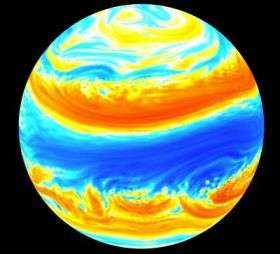Modern physics is critical to global warming research

Science has come a long way with predicting climate. Increasingly sophisticated models and instruments can zero in on a specific storm formation or make detailed weather forecasts – all useful to our daily lives. But to understand global climate change, scientists need more than just a one-day forecast. They need a deeper understanding of the complex and interrelated forces that shape climate.
This is where modern physics can help, argues Brad Marston, professor of physics at Brown University. Marston is working on sets of equations that can be used to more accurately explain climate patterns. Marston will explain his research as part of a panel discussion titled “The Physics of Climate and Climate Change,” today at the American Physical Society’s meeting in New Orleans.
“Climate is a statement about the statistics of weather, not the day-to-day or minute-by-minute fluctuations,” Marston said. “That’s really the driving concept. We know we can’t predict the weather more than a couple of weeks out. But we can turn that to our advantage, by using statistical physics to look directly at the climate itself.”
Take the drying of Lake Mead in the western United States. Scientists think the lake, which straddles Nevada and Arizona, may already be getting less rain due to shifting weather patterns caused by a warming world. Computer models can follow those rainfall patterns and forecast the likely effects on the lake. But current models obscure the larger mechanisms – such as shifting storm tracks – that can drive changes in rainfall.
“If we’re just mesmerized by the details of the model,” Marston said, “we could be missing the big picture of why it’s happening.”
Marston’s statistical approach can be used to help crack the code of complicated, dynamic atmospheric processes poorly understood through models, such as convection, cloud formation, and macroturbulence, which refers to the currents, swirls and eddies in the global atmosphere. More fundamentally, Marston said this approach can help to deepen understanding of what is happening in today’s climate and what those changes can mean for climate in the future.
“We’re trying to make the models more robust, to give better insights into what is actually going on,” he said.
Marston’s research, on which he teamed with former Brown undergraduate Emily Conover and Tapio Schneider of the California Institute of Technology, was selected last fall for publication in the Journal of the Atmospheric Sciences. Marston’s ultimate research goal is to create a more realistic rendering of the global atmospheric system that can be used to understand the atmosphere of the past and to gauge future changes.
“We’re improving the statistical methods themselves, so that they’re more accurate,” Marston said. “At the same time we are applying the methods to progressively more complete models of the Earth’s atmosphere.”
Source: Brown University





















